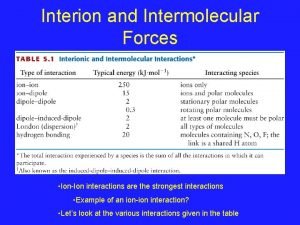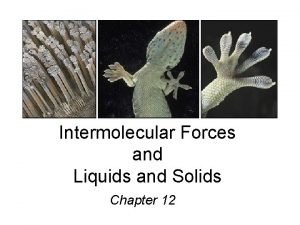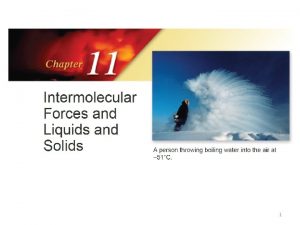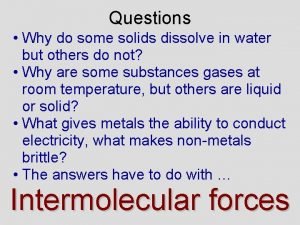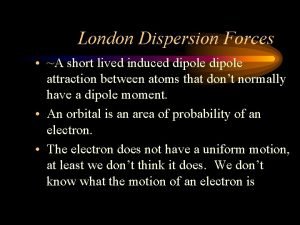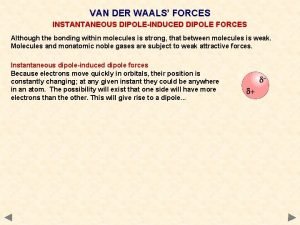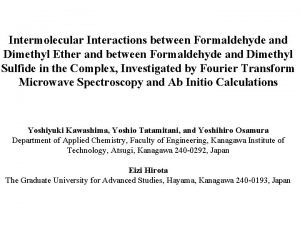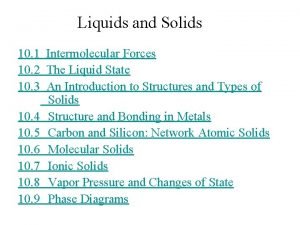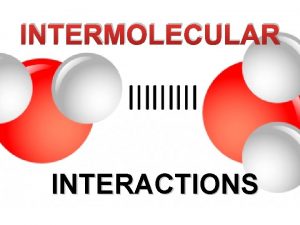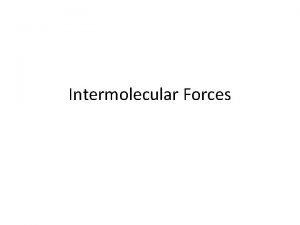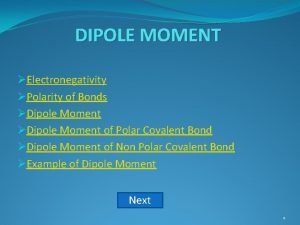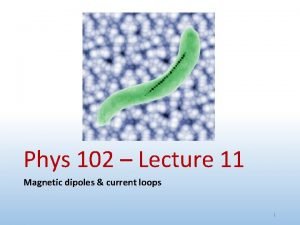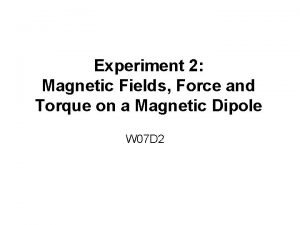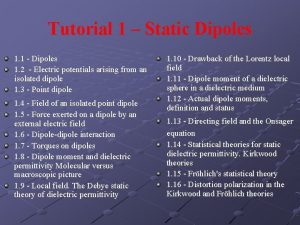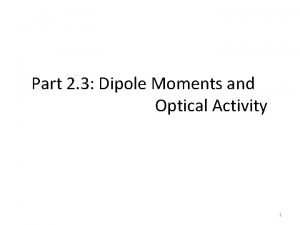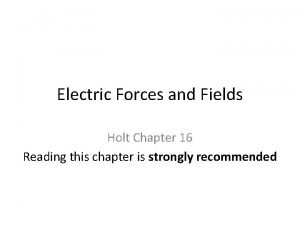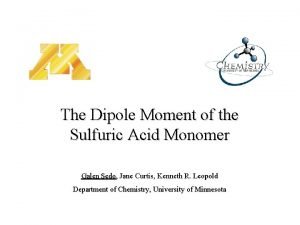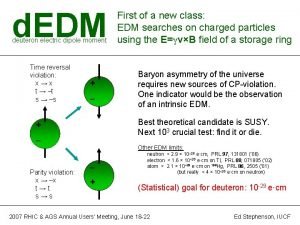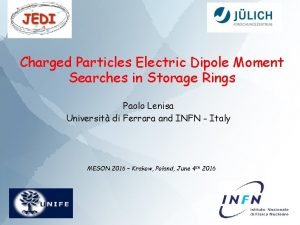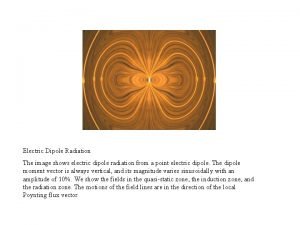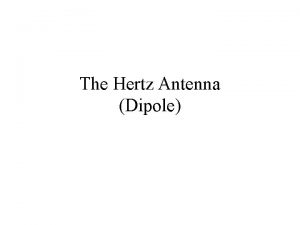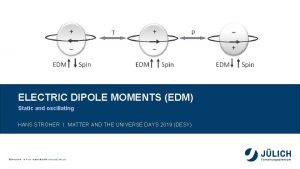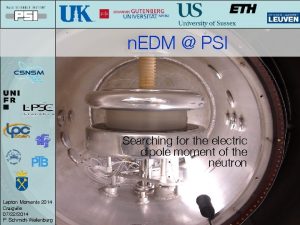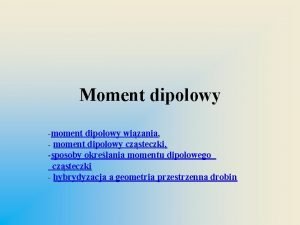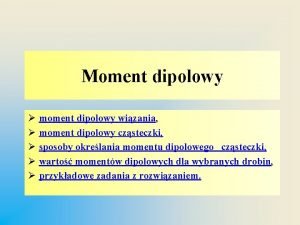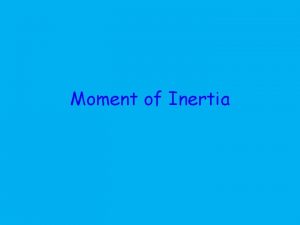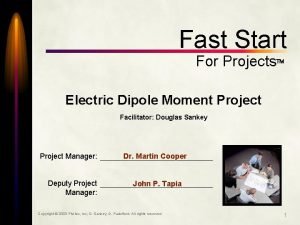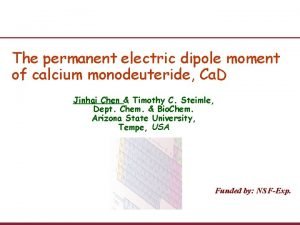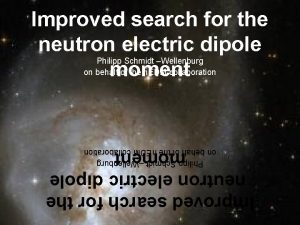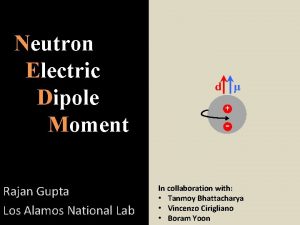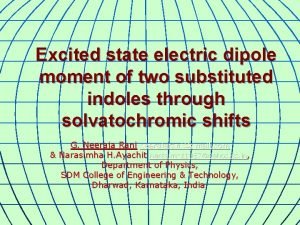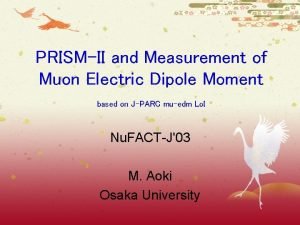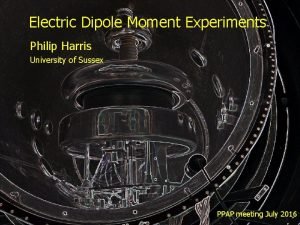Status of Electric Dipole Moment EDM Searches From

























- Slides: 25

Status of Electric Dipole Moment (EDM) Searches From NSAC 2012 Implementation Report • Role of EDM in CP Violation • Particle EDM Zoo • Future reach of EDM searches B. Filippone FCCP 2016

How big are EDMs? e. g. neutron: +2/3 e u-quark if l ~ 0. 1 rn -2(1/3 e) d-quarks dn ~ 5 x 10 -14 e-cm But Experimentsays dn < 3 x 10 -26 e-cm !! 2

T/CP Violation m d E B J P + + T + - 123 P-even T-even P-odd T-odd Non-zero d violates T and CP (via CPT) 3

But some molecules have HUGE EDMs! H 20: d = 0. 4 x 10 -8 e-cm Na. Cl: d= 1. 8 x 10 -8 e-cm NH 3: d = 0. 3 x 10 -8 e-cm But NH 3 EDM is not T-odd If neutron/electron had a degenerate state, then their EDM would not violate T or CP. But they don’t! Ground state is actually a superposition 4

EDM in Standard Model • Standard Model EDMs are due to CP violation in CKM Matrix but… – Need at least three loops to get EDM’s (electron actually requires 4 loops) W g d, s, b – Thus EDM’s are VERY small in standard model – Thus “theory error” is negligible 5

But Theory Remains Essential • Extraction of fermionic EDM from p, n, atom • Calculation of enhancement factors for certain species • Model constraints based on EDM limits/observations 6

EDM from New Physics • New physics (e. g. SUSY/other) often has new CP violating phases in added couplings – New phases: (f. CP) could be ~ 1 (why not? ) • Contribution to EDMs depends on masses of new particles e. g. dn ~ 10 -24 e-cm x sinj. CP(1 Te. V/MSUSY)2 -24 e-cm dnexp < 0. 03 x 10 • Observation of EDM in next 10 yrs must be new physics (since SM background ~ 0) with mass 7 reach > 10 - 1000 Te. V

Origin of EDMs • EDMs are from – q. QCD – Fermionic EDMs – Gluonic interactions q. QCD Weinberg 3 -gluon term CP e-, quark EDM quark color EDM (chromo-EDM)

Particle EDM Zoo (where to look? ) • Paramagnetic (unpaired electrons) atoms and polar molecules are very sensitive to • Diamagnetic (paired electrons) atoms are sensitive to quark chromo. EDM • Charged particle traps (m, p, molecular ion) sensitive to • Trapped ultracold neutrons sensitive to Observation or lack thereof in one systemdoes not necessarily predict results for other systems 9

Example of Relative EDM Sensitivities System n 199 Hg Dependence Present Limit (e-cm) Future (e-cm) dn~ (3 x 10 -16)q. QCD + <3 x 10 -26 ~10 -28 d. Hg~ (0. 001 x 10 -16)q. QCD - <7 x 10 -30 ~10 -30 10

What is the precision for an EDM measurement? Uncertainty in d: Precise energy measurement requires longcoherence/ measurement time, giving Coherence time Plus shot noise = counting statistics Sensitivity: E – Electric Field Tm – Time for single measurement m – total # of measurements 11 N – Total # of counts/meas.

Simplified Measurement of EDM E-field “Always measure a frequency” B-field Must know B very well 12

Best Present Sensitivities (90% CL) • Trapped Neutrons: – dn < 3 x 10 -26 e-cm – Institut Laue-Langevin: PRD 92, 092003 (2015). • Diamagnetic Atom: 199 Hg – d. Hg < 7 x 10 -30 e-cm – U. Washington: Graner, et al PRL 116, 161601 (2016) • Paramagnetic Polar Molecule: Th. O – de < 1 x 10 -28 e-cm – Harvard/Yale (ACME Collaboration): Baron et al. , Science 343, 269 (2014) 13

ACME Experiment: Th. O • Metastable paramagnetic state (Lasers) • Effective E-field = 78 GV/cm (with 10 V/cm applied field • Coherence time ~ 2 ms • Can flip effective E-field (Lasers) but not applied E-field (excellent control of systematic effects) • Sensitivity improved by > 10 14

Future Proposed Sensitivities • Paramagnetic Molecules ( ) – Yb. F-Imperial (x 100) – Th. O-Harvard/Yale (x 10 -100) – Cs-Penn. State (x 40) • Diamagnetic Atoms ( ) – 199 Hg-Washington (x 10) – radioactive/deformed 225 Ra-ANL (x 10) • Charged Particle Traps ( ) – Proton-Fermilab/CERN (x 104) – m -Fermilab (x 100) – Hf. F+-JILA (x 10) • Trapped Ultracold Neutrons ( ) – ILL, TRIUMF, J-PARC, SNS, LANL, PSI, FRMII, PNPI, RCNP – (x 10 -100) 15

p. EDM (from T. Bowcock) • A Storage Ring Experiment to Detect a Proton Electric Dipole Moment V. Anastassopoulos (Patras U. )et al. . Feb 15, 2015. e-Print: ar. Xiv: 1502. 04317 [physics. acc-ph ].

Worldwide neutron EDM Searches PNPI TRIUMF ILL FRMII PSI LANL J-PARC SNS RCNP 17

History of n. EDM Sensitivity 1950 2000 2010 18

Worldwide neutron EDM Searches Experiment UCN source cell Measurement techniques sd Goal (10 -28 e-cm) ILL - Cryo. EDM Superfluid 4 He Cryo HV, Super. Cond. , Ramsey technique, < 5 Present external SQUID mag. neutron EDM limit ILL-PNPI ILL turbine PNPI/Solid D 2 Vac. Ramsey technique for w E=0 cell for magnetometer Phase 1<100 < 10 ILL Crystal Cold n Beam solid Crystal Diffraction Non-Centrosymmetric crystal < 100 PSI EDM Solid D 2 Vac. Ramsey for w, external Cs & 3 He, Hg comagnetom. Xe or Hg comagnetometer Phase 1 ~ 50 Phase 2 < 5 Munich FRMII Solid D 2 Vac. Room Temp. , Hg Co-mag. , also external Cs mag. <5 RCNP/TRIUMF Superfluid 4 He Vac. Small vol. , Xe co-mag. @ RCNP Then move to TRIUMF < 50 <5 SNS n. EDM Superfluid 4 He Cryo-HV, 3 He capture for w, 3 He co-mag. with SQUIDS & dressed spins, supercond. < 300 <5 JPARC Solid D 2 Vac. Under Development <5 JPARC Solid D 2 Solid Crystal Diffraction Non-Centrosymmetric crystal < 10? LANL Solid D 2 Vac. R&D = sensitivity < 5 x 10 -28 ~ 30 e-cm 19

n. EDM Experiment at Oak Ridge Lab-SNS Concept: R. Golub & S. K. Lamoreaux, Phys. Rep. 237, 1 (1994) “Most ambitious n. EDM experiment that is underway” • Higher trapped neutron densities – high Ultracold neutrons from phonons in LHe • LHe as a high voltage insulator – high electric fields • Use of a 3 He co-magnetometer and superconducting shield – Control and measure magnetic field systematics • Precession frequency measurement via two techniques: • free precession • dressed spin techniques • Sensitivity reach: dn ~ 2 x 10– 28 e • cm (in calendar 3 yrs)

SNS-n. EDM COLLABORATION R. Alarcon, R. Dipert S. Clayton, S. Currie, T. Ito, Y, Kim, M. Makela, J. Ramsey, W. Sondheim Arizona State University Los Alamos National Lab G. Seidel K. Dow, D. Hasell, E. Ihloff, J. Kelsey, J. Maxwell, R. Milner, R. Brown University Redwine, E. Tsentalovich, C. Vidal D. Budker Massachusetts Institute of Technology UC Berkeley D. Dutta, E. Leggett Mississippi State University M. Blatnik, R. Carr, B. Filippone, C. Osthelder, S. R. Golub, C. Gould, D. Haase, A. Hawari, P. Huffman, Slutsky, X. Sun, C. Swank E. Korobkina, K. Leung, A. Reid, A. Young California Institute of Technology North Carolina State University M. Ahmed, M. Busch, P. –H. Chu, H. Gao R. Allen, V. Cianciolo, Y. Efremenko, P. Mueller, Duke University S. Penttila, W. Yao I. Silvera Oak Ridge National Lab Harvard University M. Hayden Simon Fraser University M. Karcz, C. -Y. Liu, J. Long, H. O. Meyer, M. Snow G. Greene, N. Fomin Indiana University of Tennessee L. Bartoszek, D. Beck, C. Daurer, J. -C. Peng, T. Rao, S. Stanislaus S. Williamson, L. Yang Valparaiso University of Illinois Urbana-Champaign S. Baeβler C. Crawford, T. Gorringe, W. Korsch, University of Virginia E. Martin, N. Nouri, B. Plaster S. Lamoreaux Yale University of Kentucky Project Manager: V. Cianciolo Spokesperson: B. Filippone 21

SNS-n. EDM Experiment 3 He ATOMIC BEAM SOURCE MAGNETIC SHIELD HOUSE 3 He DILUTION REFRIGERATOR CENTRAL DETECTOR SYSTEM Neutron beam is into page 22

Status of the Experiment • Demonstration of Critical Components is Underway (2014 -2017) – Construction of most technically challenging pieces: • Magnet system @ Caltech • Polarized 3 He system @ Illinois • HV and light detection system @ Los Alamos National Lab • Large Scale Integration (2018 -2020) – Begin commissioning components at Oak Ridge National Laboratory in 2019

Future n. EDM Sensitivity Future neutron EDM 1950 2000 2010 2020 24

Summary • Greatly improved EDM sensitivity can probe BSM physics at very high mass scales • A number of exciting technologies are being developed to extend EDM sensitivities (p, n, m, atoms, polar molecules) by more than two orders-ofmagnitude 25
 Dipole dipole vs ion dipole
Dipole dipole vs ion dipole Alur perencanaan penganggaran madrasah
Alur perencanaan penganggaran madrasah Electric dipole moment
Electric dipole moment Dipole dipole bond
Dipole dipole bond Force de london
Force de london Dipole induced dipole forces examples
Dipole induced dipole forces examples London dispersion forces induced dipole
London dispersion forces induced dipole Dispersion forces vs dipole dipole
Dispersion forces vs dipole dipole Instantaneous dipole induced dipole
Instantaneous dipole induced dipole Intermolecular force of hydrogen bonding
Intermolecular force of hydrogen bonding Dimethyl ether intermolecular forces
Dimethyl ether intermolecular forces Dipole-dipole attractions
Dipole-dipole attractions Dipole induced dipole interaction
Dipole induced dipole interaction Intermolecular forces of attraction
Intermolecular forces of attraction Dipole-dipole interaction example
Dipole-dipole interaction example Dispersion forces vs dipole dipole
Dispersion forces vs dipole dipole Dipole moment definition chemistry
Dipole moment definition chemistry Dipole moment of thulium nucleus
Dipole moment of thulium nucleus Magnetic moment
Magnetic moment Magnetic dipole moment
Magnetic dipole moment Magnetic dipole moment
Magnetic dipole moment Polarizability dipole moment
Polarizability dipole moment Symmetry molecules
Symmetry molecules Direction of dipole moment
Direction of dipole moment Dipole moment of h2so4
Dipole moment of h2so4 Potential and potential difference
Potential and potential difference
